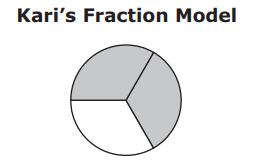Remarks
Examples of Opportunities for In-Depth FocusExtending fraction equivalence to the general case is necessary to extend arithmetic from whole numbers to fractions and decimals.
Clusters should not be sorted from Major to Supporting and then taught in that order. To do so would strip the coherence of the mathematical ideas and miss the opportunity to enhance the major work of the grade with the supporting clusters.
- Assessment Limits :
Denominators of given fractions are limited to: 2, 3, 4, 5, 6, 8, 10, 12, 100. For items with denominators of 10 and 100, focus may not be on equivalence between these 2 denominators, since this is addressed specifically in standards MAFS.4.NF.5 – 7, but should focus on equivalence between fractions with denominators of 2, 4, and 5, and fractions with denominators of 10 and 100, e.g., , etc.
, etc. Fractions must refer to the same whole, including in models. Fraction models are limited to number lines, rectangles, squares, and circles. Fractions
 can be fractions greater than 1 and students may not be guided to
put fractions in lowest terms or to simplify.
Equivalent fractions also include fractions
can be fractions greater than 1 and students may not be guided to
put fractions in lowest terms or to simplify.
Equivalent fractions also include fractions  .
. - Calculator :
No
- Context :
Allowable
- Test Item #: Sample Item 1
- Question:
Select all the models that have been shaded to represent fractions equivalent to

- Difficulty: N/A
- Type: MS: Multiselect
- Test Item #: Sample Item 2
- Question:
Corey tried to find a fraction equivalent to
 . His work is shown.
. His work is shown.
Which statement describes Corey's error?
- Difficulty: N/A
- Type: MC: Multiple Choice
- Test Item #: Sample Item 3
- Question:
Kari represented a fraction by shading parts of the model shown.

Select all the models that have been shaded to represent fractions equivalent to Kari’s fraction.
- Difficulty: N/A
- Type: MS: Multiselect
Related Courses
Related Access Points
Related Resources
Formative Assessments
Image/Photograph
Lesson Plans
Original Student Tutorials
Problem-Solving Tasks
Tutorial
Virtual Manipulatives
MFAS Formative Assessments
Students partition squares to model two fractions and then determine if the fractions are equivalent.
Students draw a visual fraction model to determine whether two fractions are equivalent.
Students use a number line to explain that one-half is equivalent to two-fourths.
Students scale number lines to locate given fractions, find equivalent fractions, and explain the relationship between equivalent fractions.
Original Student Tutorials Mathematics - Grades K-5
Learn how to create equivalent fractions and visually see how they are equivalent in this interactive tutorial.
This is part 1 of a 2-part series. Click HERE to open Part 2.
Learn how to find equivalent fractions in a multiplication table in this interactive tutorial.
This is part 2 of a 2 part series. Click HERE to open Part 1.
Student Resources
Original Student Tutorials
Learn how to create equivalent fractions and visually see how they are equivalent in this interactive tutorial.
This is part 1 of a 2-part series. Click HERE to open Part 2.
Type: Original Student Tutorial
Learn how to find equivalent fractions in a multiplication table in this interactive tutorial.
This is part 2 of a 2 part series. Click HERE to open Part 1.
Type: Original Student Tutorial
Problem-Solving Tasks
The purpose of this task is to provide students with an opportunity to explain fraction equivalence through visual models in a particular example. Students will need more opportunities to think about fraction equivalence with different examples and models, but this task represents a good first step.
Type: Problem-Solving Task
The purpose of this task is for students to compare two fractions that arise in a context. Because the fractions are equal, students need to be able to explain how they know that. Some students might stop at the second-to-last picture and note that it looks like they ran the same distance, but the explanation is not yet complete at that point.
Type: Problem-Solving Task
Tutorial
This Khan Academy video illustrates that fraction a/b is equivalent to fraction (a x n)/(b x n).
Type: Tutorial
Virtual Manipulatives
Match shapes and numbers to earn stars in this fractions game.
- Match fractions using numbers and pictures
- make the same fractions using different numbers
- Match fractions in different picture patterns
- Compare fractions using numbers and patterns
Type: Virtual Manipulative
This virtual manipulative allows individual students to work with fraction relationships. (There is also a link to a two-player version.)
Type: Virtual Manipulative
Parent Resources
Image/Photograph
Illustrations that can be used for teaching and demonstrating fractions. Fractional representations are modeled in wedges of circles ("pieces of pie") and parts of polygons. There are also clipart images of numerical fractions, both proper and improper, from halves to twelfths. Fraction charts and fraction strips found in this collection can be used as manipulatives and are ready to print for classroom use.
Type: Image/Photograph
Problem-Solving Tasks
The purpose of this task is to provide students with an opportunity to explain fraction equivalence through visual models in a particular example. Students will need more opportunities to think about fraction equivalence with different examples and models, but this task represents a good first step.
Type: Problem-Solving Task
The purpose of this task is for students to compare two fractions that arise in a context. Because the fractions are equal, students need to be able to explain how they know that. Some students might stop at the second-to-last picture and note that it looks like they ran the same distance, but the explanation is not yet complete at that point.
Type: Problem-Solving Task
Virtual Manipulative
Match shapes and numbers to earn stars in this fractions game.
- Match fractions using numbers and pictures
- make the same fractions using different numbers
- Match fractions in different picture patterns
- Compare fractions using numbers and patterns
Type: Virtual Manipulative









